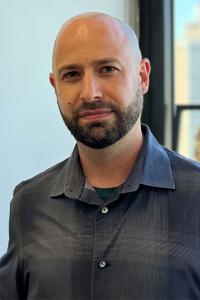Luke E. Berchowitz, PhD
- Associate Professor of Genetics and Development (in the Taub Institute for Research on Alzheimer's Disease and-the Aging Brain)

Overview
Academic Appointments
- Associate Professor of Genetics and Development (in the Taub Institute for Research on Alzheimer's Disease and-the Aging Brain)
Gender
- Male
Credentials & Experience
Education & Training
- Molecular Biology, University of North Carolina
- 2002 Integrative and Medical Biology, Beloit College
- Fellowship: 2016 Massachusetts Institute Technology
Research
Our goals are to discover and understand the pathways and mechanisms by which cells regulate formation, function, and reversibility of amyloids and amyloid-like assemblies. We utilize budding yeast as a tractable model experimental system to investigate the inner workings of amyloid biology in the setting of normal cellular physiology
Sexually reproducing organisms employ a specialized developmental program to generate cells that are used to pass genetic material from one generation to the next. These reproductive cells, called gametes, contain half the DNA complement of a typical cell and are known to us as sperm, eggs, pollen, and spores etc. A hallmark feature of gamete development is a marked decrease in mRNA production (i.e. transcriptional control) and a concurrent emphasis on genetic regulation at the level of protein synthesis (i.e. translational control). We discovered that in order to control translation during gamete development, budding yeast builds massive RNA-binding protein structures that exhibit biochemical properties of amyloid (thus termed ‘amyloid-like’). Our research goals are to discover and understand the pathways and mechanisms by which cells regulate formation, function, and reversibility of amyloids. We strive to expand our understanding of birth defects and fertility while also providing key insights into principles underlying neurodegenerative disease.
Amyloids are fibrous protein aggregates that are predominantly understood for their roles in the etiology of neurodegenerative diseases including Alzheimer’s, Parkinson’s, and prion diseases. What is remarkable about amyloid-like assemblies in yeast is that they are not pathogenic- on the contrary they are both functional and regulated. These structures bind to and repress translation of key transcripts and are essential for gamete production. Formation of these repressors is regulated by starvation and clearance is regulated by precise developmental cues. Regulated amyloid-like assemblies are also features of mouse and frog meiosis highlighting their evolutionary conservation and likely ancient evolutionary origin in sexual reproduction.
Our lab employs genetic, cell biological, and biochemical approaches to understand the pathways and mechanisms underlying formation and clearance of amyloid-like assemblies. We also use a combination of in vitro and in vivo approaches to decipher how translation can be regulated by this intriguing class of RNA-binding structures. We are also using yeast to screen and identify compounds that prevent and/or disassemble amyloid-like assemblies. The compounds that we identify in this manner will be excellent potential therapeutics for neurodegenerative disease. Lastly, we are investigating the hypothesis that mammalian sperm development also relies on amyloid-like assemblies to regulate gene expression.
Our studies will lay the foundation for understanding the molecular underpinnings of how cells regulate and process amyloid-like assemblies. Each finding provides the potential lead to a pathway or gene that could be a therapeutic target. Despite much research and development, anti-amyloid preventative therapies have been elusive. They are needed for neurodegenerative diseases in which few if any effective preventative therapies are currently available. Therapeutic strategies resulting from this work will rely on my ability to apply the findings we gain from this study to neurodegenerative disease models. Columbia University Medical Center and the Taub Institute for Alzheimer’s and Aging Research provide the supportive framework and collaborative opportunities to make this possible.
Research Interests
- Maintenance of genome integrity
- Meiosis and reproductive biology
- Protein folding and amyloidogenesis
- RNA Biology
Selected Publications
1. Berchowitz, LE, Kabachinski G, Walker MR, Carlile TM, Gilbert WV, Schwartz TU, Amon A. : (2015) Regulated formation of an amyloid-like translational repressor governs gametogenesis . Cell 163(2): 406-418
2. Berchowitz LE, Gajadhar A, van Werven FJ, De Rosa AA, Samoylova ML, Brar GA, Xu Y, Xiao C, Futcher B, Weissman JS, White F, Amon A.
: (2013) A developmentally-regulated translational control pathway establishes the meiotic chromosome segregation pattern . Genes and Development 27(19): 2147-2163
3. Berchowitz LE, Hanlon SE, Lieb JD, Copenhaver GP.
: (2009) A positive but complex association between meiotic double-strand break hotspots and open chromatin in Saccharomyces cerevisiae
. Genome Research 19(12): 2245-57
4. Berchowitz LE, Copenhaver GP.: (2008) Fluorescent Arabidopsis tetrads: A visual assay for quickly developing large crossover and crossover interference datasets
. Nature Protocols 3(1): 41-50*
5. Berchowitz LE, Francis KE, Bey AL, Copenhaver GP: (2007) The role of AtMUS81 in interference-insensitive crossovers in A. thaliana. PLoS Genetics 3(8): e132
6. Berchowitz LE, Copenhaver GP: (2010) Genetic interference: don't stand so close to me. Current Genomics 11(2): 91-102